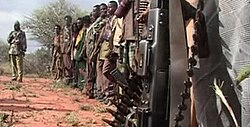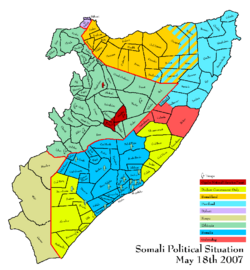2007–2008 Ethiopian crackdown in Ogaden
Topic: Social
 From HandWiki - Reading time: 7 min
From HandWiki - Reading time: 7 min
| Ethiopian crackdown in Ogaden | |||||||
|---|---|---|---|---|---|---|---|
| Part of the Insurgency in Ogaden | |||||||
 Ogaden rebels filmed in an Al-Jazeera report. | |||||||
| |||||||
| Belligerents | |||||||
|
|
| ||||||
| Commanders and leaders | |||||||
|
| Unknown | ||||||
| Casualties and losses | |||||||
|
375 killed (Ethiopian claim[2]) 950 killed (ONLF claim[3][4]) | ~500 killed (Ethiopian claim[5]) | ||||||
|
Civilian casualties: <1,000 killed[6] | |||||||
The 2007–2008 Ethiopian crackdown in Ogaden was a military campaign by the Ethiopian Army against the Ogaden National Liberation Front (ONLF). The crackdown against the guerrillas began after they killed 74 people in an attack on a Chinese-run oil exploration field in April 2007.
The main military operations were centered on the towns of Degehabur, Kebri Dahar, Werder and Shilavo in Ogaden, which are in the Ethiopian Somali Region. The area is home to the Ogaden clan, seen as the bedrock of support of the ONLF.[7]
According to Human Rights Watch (HRW), various human rights abuses were committed by the Ethiopian military.[8]
Background
Insurgency
Ethiopia's eastern Somali Region, whose major part constitutes the Ogaden, is the site of a long-running, low-intensity armed conflict between the Ethiopian Government and the ONLF.[9] Formed in 1984, many of the ONLF's members had supported Somalia in the Ogaden War with Ethiopia over the region in the 1970s. The group's aims have varied over time from independence to joining a "greater Somalia" or obtaining greater autonomy within Ethiopia.[10]
April–May 2007 ONLF attacks
| List of abbreviations used in this article ONLF: Ogaden National Liberation Front |
Timeline
On October 21, 2007, the ONLF stated its forces had killed 250 soldiers during the battle near the town of Werder. There was no confirmation of the attack either from the Ethiopian Government or from independent sources.[11] On November 4, the ONLF claimed that up to 270 Ethiopian soldiers had been killed in clashes between October 26 and November 1. Once again, the claim could not be independently verified.[12]
On November 16, 2007, the Ethiopian Army claimed to have killed 100 ONLF fighters during the past month, and to have captured hundreds more.[13][14] On November 18, 2007, the ONLF reported that the Ethiopian Air Force had carpet bombed villages and nomadic settlements the Ogaden region, killing up to a dozen civilians.[14][15] An ONLF spokesman also said that some ONLF fighters were hurt in the air bombardments, but the air force targeted civilian settlements and livestock.[14] The Ethiopian Government denied these reports on November 20.[16] On November 28, 2007, Ogaden residents described continued abuses on the part of the military, but also said that aid delivery had improved.[17] UN humanitarian chief John Holmes said the humanitarian situation in Ogaden as "potentially serious" but not yet catastrophic.[17] Prime Minister Meles Zenawi said that human rights abuses and a humanitarian crisis "didn't exist. Doesn't exist. Will not exist."[17]
In January 2009, the foreign relations chief Mohammed Sirad was killed by Ethiopian security forces at the town of Danan as he met with other ONLF members.[18] Reportedly this has led to the ONLF splitting into two factions, with one group allied to current ONLF chairman Mohammed Omar Osman, and the other led by senior leader Abdiwali Hussein Gas, who appointed Salahudin Ma'ow as the new ONLF chairman and declared that he will "bring Mohammed Omar Osman to court".[19]
Allegations of human rights abuses
Abuses perpetrated by the Ethiopian military
Ethiopia's military campaign has triggered a serious humanitarian crisis, according to several humanitarian organisations.
According to Human Rights Watch, civilians in the Somali Region were trapped between the warring parties. HRW learned that dozens of civilians have been killed in what appeared to have been a deliberate effort to mete out collective punishment against a civilian population suspected of sympathizing with the rebels.[20]
Refugees fleeing the crackdown told stories of widespread violence, with entire villages being destroyed along with arbitrary theft, rape and murder by Ethiopian soldiers.[21] In October 2007, The Independent reported that the situation in Ogaden had begun to mirror the Darfur conflict, with refugees stating that government troops had burned villages and raped and killed civilians.[22] Earlier in the month, Human Rights Watch had told the United States House Foreign Affairs Subcommittee on Africa and Global Health that "the Ogaden is not Darfur. But the situation in Ogaden follows a frighteningly familiar pattern", while recognizing that "Ethiopia has legitimate and serious domestic and regional security concerns".[23][24] Also, the United Nations advocacy director for Human Rights Watch has called Ogaden a "mini-Darfur". Human Rights Watch says it has documented dozens of cases of severe abuse by Ethiopian troops in the Ogaden, including gang rapes, burned villages and what it calls "demonstration killings," like hanging and beheading of populace, meant to terrorize the population.[25]
Forceful draft of civilians
Several Ethiopian refugees and international organizations reported in December 2007 that the Ethiopian military, strained by its deployment in Somalia, was forcing local civilians (including government employees and health workers) to fight alongside troops against the ONLF rebels. According to the same reports, these under-equipped and poorly trained militias suffered heavy casualties in several battles. One Western aid official said soldiers barged into hospitals to draft recruits and threatened to jail health workers if they did not comply. In other cases, lists of names were posted on public bulletin boards, ordering government employees to report for duty, according to a current member of the regional parliament and two Ethiopian administrators who have fled the country. Many of those who refused were fired, jailed and in some cases tortured, the administrators and parliament member said.[26]
Ethiopian officials denied the charges, claiming that local tribes were willingly forming defense groups against the ONLF. Several United Nations officials and Western diplomats said they were discussing the militia program in private meetings, but contended they could not comment publicly for fear of provoking the ire of the Ethiopian government, resulting in a possible suspension of humanitarian efforts in the region.[26]
Expulsions of humanitarian agencies
Large segments of the region were inaccessible to outside agencies as Ethiopian troops attempted to suppress the rebel insurgency.[27]
On November 6, the United Nations Office for the Coordination of Humanitarian Affairs (OCHA) announced opening an aid facility in the Ogaden region. The U.N. has also called for an independent investigation into allegations of human rights abuses by Ethiopian forces in the region. Government troops are fighting ONLF rebels who want more autonomy for their region.[28] Médecins Sans Frontières is among the 12 organizations that have received permission to work in Ogaden, while the ICRC is still barred from working in the region.[28]
The Eritrea and Somalia factors
Experts say the ONLF was active in the Somali capital Mogadishu during 2006 while that city was controlled by the Islamic Courts Union, and that some Islamist fighters may have fled to Ogaden after they were ousted from Mogadishu.[7]
See also
- Ogaden War
- Ethiopian Civil War
- War in Somalia (2006–2009)
- List of wars 2003-current
References
- ↑ "Ethiopia says troops to stay in Somalia - International Herald Tribune". http://www.iht.com/articles/reuters/2008/05/21/africa/OUKWD-UK-SOMALIA-ETHIOPIA.php.
- ↑ [1]
- ↑ "Ogaden rebels say 43 Ethiopian soldiers killed in ambush attack ," Sudan Tribune, July 3, 2007.
- ↑ "Ethiopia army claims killing around 100 Ogaden rebels ," AFP, November 16, 2007.
- ↑ "Ethiopia says 500 Ogaden rebels killed," NEWS.com.au, August 8, 2007. [|permanent dead link|dead link}}]
- ↑ McLure, Jason. "Caught in Ethiopia’s War ," Newsweek, January 22, 2008.
- ↑ 7.0 7.1 Ethiopia Ogaden crisis , Reuters AlertNet, 1st December, 2007.
- ↑ "Collective Punishment: War Crimes and Crimes against Humanity in the Ogaden area of Ethiopia's Somali Regional State: Summary". Hrw.org. http://hrw.org/reports/2008/ethiopia0608/3.htm.
- ↑ Ethiopia: Crackdown in East Punishes Civilians , Human Rights Watch, July 4, 2007.
- ↑ Unrest simmers in Ethiopia's Ogaden , AlJazeera, April 15, 2008.
- ↑ "Rebels claim 250 troops killed," Herald Sun, October 23, 2007.
- ↑ "Ethiopian rebels claim killing of more than 270 troops". Google News (AFP). 2007-11-05. http://afp.google.com/article/ALeqM5jkYVHTU5dmHVTYwT-KQXHINO1C-A. "'In the period 26 October through 1st November these engagements resulted in over 270 troops killed with an unconfirmed number wounded,' the Ogaden National Liberation Front (ONLF) group said in a statement."
- ↑ "Ethiopia army claims killing around 100 Ogaden rebels". Google News (AFP). 2007-11-16. http://afp.google.com/article/ALeqM5jjE3h6c4Bel630GMHcelOa0aZqFw. "'Around 100 terrorists from the ONLF have been killed after regrouping in the Lander area,' the television quoted Colonel Gebregziabher Beyene, an army field commander as saying. 'Several hundred others, including seven top leaders and two Eritreans, were captured,' he said, explaining that small arms, RPG launchers and explosives were recovered."
- ↑ 14.0 14.1 14.2 "Ethiopia 'bombs' Ogaden villages". BBC News (BBC). 2007-11-19. http://news.bbc.co.uk/2/hi/africa/7101598.stm. "Separatist rebels in Ethiopia's Ogaden region say days of air attacks on civilians have caused many casualties."
- ↑ Gettleman, Jeffrey. "Separatist Rebels Accuse Ethiopia’s Military of Killing Civilians in Remote Region ," The New York Times , November 20, 2007.
- ↑ "Ethiopia denies reports of Ogaden helicopter attacks". Reuters Africa (Reuters). 2007-11-20. http://africa.reuters.com/wire/news/usnL2058394.html. "'The so-called air and helicopter attacks in the Somali region never happened,' Information Ministry spokesman Zemedkun Tekele said."
- ↑ 17.0 17.1 17.2 "Soldiers continue human rights abuses in Ethiopia's beleaguered southeast, say residents". International Herald Tribune. Associated Press. 2007-11-28. http://www.iht.com/articles/ap/2007/11/28/africa/AF-GEN-Ethiopia-Beleaguered-Region.php. "Ethiopian soldiers have abused civilians, committing arson and rape, in a southeastern area where they are fighting rebels, but there have been some improvements in aid delivery, residents said."
- ↑ "Senior ONLF leader Killed" . Retrieved 27 January 2009.
- ↑ "Ethiopia: Ogaden's ONLF breaks into two factions" , Jimma Times, 3 March 2009 . Retrieved 9 March 2009.
- ↑ Porteous, Tom."Ethiopia's dirty war ," Guardian Unlimited (re-published by Human Rights Watch), August 05, 2007.
- ↑ Ethiopia starves, kills own people, its refugees say ," GaroweOnline , September 15, 2007.
- ↑ Bloomfield, Steve (2007-10-17). "Ethiopia's 'own Darfur' as villagers flee government-backed violence". The Independent. London: Independent News and Media Ltd. http://news.independent.co.uk/world/africa/article3067244.ece. "[Refugees'] stories reveal the brutality of Ethiopia's hidden war, a brutal counter-insurgency that some aid officials believe has parallels with Darfur."
- ↑ Saman Zarifi. "Testimony of Saman Zarifi, Human Rights Watch's Washington Advocate". U.S. House of Representatives Committee on Foreign Affairs. http://foreignaffairs.house.gov/110/zar100207.htm.
- ↑ Kennedy, Brian (2007-10-03). "Ethiopia: Advocate Says Ogaden Crisis Strikingly Similar to Darfur". AllAfrica.com. AllAfrica. http://allafrica.com/stories/200710031116.html.
- ↑ Gettleman, Jeffrey. "In Rebel Region, Ethiopia Turns to Civilian Patrols ," The New York Times , December 14, 2007.
- ↑ 26.0 26.1 Gettleman, Jeffrey. "Civilians are forced to fight Ethiopian rebels ," International Herald Tribune, December 14, 2007.
- ↑ Ethiopia rebels 'agree UN truce' , BBC News, September 2, 2007.
- ↑ 28.0 28.1 Malone, Barry (2007-11-06). "UN to open office in Ethiopia's troubled Ogaden". Africa.reuters.com (Reuters). http://africa.reuters.com/wire/news/usnL06251906.html.
External links
- Ethiopia: Crackdown in East Punishes Civilians (HRW)
- Ethiopia's dirty war (Guardian Unlimited)
- Ethiopia to press Ogaden campaign despite criticism (Garowe Online)
- In the shadow of Ethiopia's rebels (BBC)
- Connors, Will (2007-09-05). "Why We Don't Hear About the Conflict in the Ogaden: When an American reporter started digging, he was forced out of Ethiopia". Slate. http://www.slate.com/id/2173264/.
- "Unrest simmers in Ethiopia's Ogaden". Al Jazeera. 2008-04-15. http://english.aljazeera.net/NR/exeres/674C444B-B772-4A5D-982E-384399CC8010.htm.
- Crisis briefing on the violence in the Ogaden region from Reuters AlertNet
 KSF
KSF

